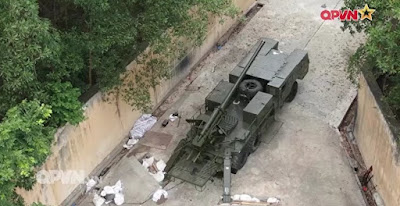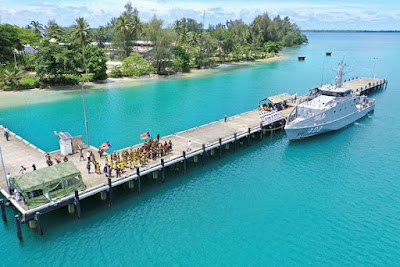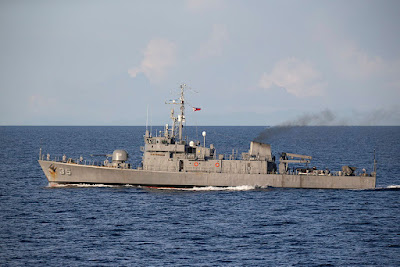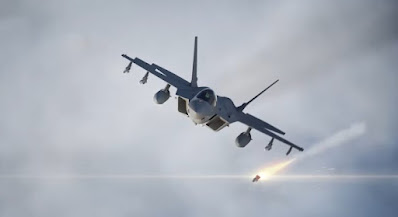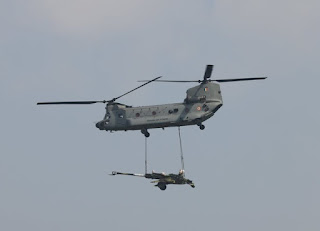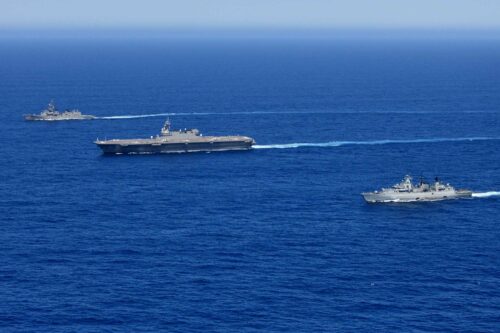October 29, 2021
Australia and Indonesia Conduct Combined Maritime Patrol
KRI Sura, HMAS Ararat and KRI Kerapu sail together in a coordinated maritime security patrol as part of AUSINDO CORPAT 2021 (photo : AusDoD)
The Royal Australian Navy (RAN) and the Indonesian Navy (TNI-AL) have completed a coordinated maritime patrol to enhance security along our shared maritime border as part of AUSINDO CORPAT 2021.The five-day patrol conducted by Armidale Class Patrol Boat HMAS Ararat and TNI-AL vessels KRI Kerapu and KRI Sura was the eleventh iteration of AUSINDO CORPAT and reflected the enduring defence partnership between Australia and Indonesia.
AUSINDO CORPAT took place in the waters between Australia and Indonesia, with a specific focus on the deterrence of illegal fishing.Commander of the Australian Fleet, Rear Admiral Mark Hammond, said the coordinated patrol demonstrated Australia’s enduring commitment to the Indo-Pacific region.
“Indonesia is an essential partner for Australia. We share security challenges and a firm commitment to a rules-based maritime order, underpinned by adherence to international law,” Rear Admiral Hammond said. AUSINDO CORPAT tested and proved our shared mariner skills, techniques and procedures and refined our ability to work together in cooperative maritime surveillance, security and interdiction.”
“By working together, we improve regional maritime security and promote a stable, inclusive and resilient region based on international law.” The coordinated patrol was conducted in a contactless manner to help prevent the spread of COVID-19.
DTI Thailand Delivered DTI-2 122mm Rocket Launcher
Thai Defense Technology Institute (DTI) hands-on modified Chinese Norinco Type 85 Self-Propelled Artillery Rocket Launcher (YW306) with 30 tubes 130mm rocket that replaced with domestic DTI-2 20 tube 122mm rocket to Royal Thai Army (RTA) at Artillery Division, Fort Sirikit, Lopburi province on 23 September 2021 (all photos : DTI)
Multiple-launched rockest system, Type 85, which has been in service in the Royal Thai Army (RTA) since 1988, is based on tracked vehicle Type 85 produced by Norinco China, which has been in service in the Royal Thai Army since 1987.
While RSP 30 Type 85 has been renovated and will continue to be stationed, but the Type 85 multi-barreled rocket launcher, size 130mm, 10 pipes, installed with the original Type 85 system, is an obsolete system that has a firing range of only 10 km and has a long service life already trusted.Modification project, MLRS Type 85, installed a multi-barreled rocket launcher DTI-2, size 122mm, 20 tubes, firing range 40km, arrived at the stage of delivery to the Royal Thai Army for testing on September 23, 2021.
Defense Technology Institute DTI (Defence Technology Institute) has tested the launch of the DTI-2 122mm multi-barreled rocket launcher installed on the MLRS Type 85 several times.
As part of DTI's high-performance rocket development program, the 122mm DTI-2 rocket is a fully self-developed system by Thailand. It has been tested several times with the Thai Army's 40-tubes SR4 self-propelled rocket launcher system.
DTI also has a multi-purpose rocket project, together with the Royal Thai Navy (RTN) based on the Israeli Elbit Systems PULS (Precise & Universal Launching System) self-propelled rocket launcher system.
South Korea, Indonesia Move Closer to KF-21 Agreement, Says DAPA
DAPA has said South Korea and Indonesia are “narrowing the gap” on an agreement on Jakarta's payments on the programme to develop the KF-21 fighter aircraft, seen here at the launch of the platform's first prototype (photo : nate.news)
South Korea and Indonesia are edging closer to an agreement about Jakarta's financial commitment to the programme to develop the KF-21 Boramae multirole fighter aircraft, the Defense Acquisition Program Administration (DAPA) in Seoul told Janes.
A DAPA spokesperson said that the two countries remain in talks over Indonesia's payments on the project but that the agency is confident that an agreement can be reached soon. The spokesperson also indicated that once the agreement is in place, Indonesia's position in the KF-21 programme could expand.
“The Republic of Korea and Indonesia are narrowing the gap between each other's position with regards to repayments through a number of negotiations,” said the DAPA spokesperson. “DAPA is very positive that the payment issue will be resolved.”
In 2015 the two countries agreed to invest KRW8.8 trillion (USD7.5 billion) to develop the KF-21, with Indonesia paying 20% of development costs in return for access to technologies and know-how. Under this accord, payments were scheduled to be made by Indonesia through to 2028, but Jakarta ceased these imbursements in March 2020.
Negotiations since then have been aimed at finalising a new repayment structure that Indonesia is willing to adhere to. Pointing to a commitment to the programme, Indonesia sent more than 30 engineers to rejoin the KF-21 programme in August 2021 and their number is expected to grow to approximately 100 by the end of the year. The engineers had ceased work on the programme in 2020 due to the Covid-19 pandemic.
October 28, 2021
Australia Issues $5.1 Bio Tender for AWD Destroyer Support
Critical role for industry in $5.1 billion support of Hobart class destroyers
Australia’s defence industry will act as a ‘steward’ for the Royal Australian Navy’s Hobart class destroyers under a new approach to sustainment that will optimise the destroyers’ capability and create hundreds of jobs in South Australia.
Tenders opened today for a Capability Life Cycle Manager, which will see industry support and sustain the destroyers through their lifespan.
Minister for Defence Industry Melissa Price encouraged Australian industry to become part of an innovative new model sustaining Navy’s ships.
“This model builds on the success of our continuous naval shipbuilding initiative and has been designed to ensure we can continue to deliver complex naval capability at sea that is reliable and fit-for-purpose,” Minister Price said.
“It includes performing asset management for the capability and supporting the upgrade of their combat management system.
“Once again the Morrison Government is delivering enormous opportunities for Australia’s defence industry, particularly in South Australia.”
The Morrison Government will invest up to $5.1 billion for the upgrades at the Osborne Naval Shipyard in South Australia – creating 300 jobs in the State – as part of a major expansion of Australia’s naval capabilities announced on 16 September 2021.
The destroyers will be the first major platform to have a Capability Life Cycle Manager, a further step in the realisation of the Future Maritime Sustainment Model under Plan Galileo – Defence’s new national, innovative approach to sustainment.
It follows the appointment of Raytheon as the Capability Life Cycle Manager for the new Arafura class offshore patrol vessels in December 2020.
An Industry Briefing will be held about the Hobart class destroyer Capability Life Cycle Manager on 4 November 2021.
Tenders will need to be received on or before 21 January 2022.
Vietnam Unveils Locally Made Self Propelled Howitzer
PTH-130 - K255B (Vietnamese: Pháo Tự Hành 130 ly - Khung Gầm KrAZ-255/English: KrAZ-255-mounted 130mm self-propelled field gun) of Vietnam People Army making a surprise apperance on a QPVN channel. The PTH130-K225B 130mm SPG developed by the Military Technical Institute.
The Vietnamese SPG strongly resembles Cuba's Jupiter V SPG and is implied to be based upon it due to Cuban-Vietnamese military cooperation. Both use the older Soviet M1954 (M-46) 130mm towed field gun as their main weapon.
The intention to create the PTH130-K225B can be traced back to 2017 after it was announced that plans would be made to do so following the successful trials of the PTH105 (old American 105mm howitzers on the chassis of a Ural).Other militaries in Southeast Asia have opted to supplement or completely replace their towed artillery with SPGs. Now the People's Army of Vietnam will be able to follow suit.
October 27, 2021
Ukraine has use the Bayraktar TB2 in combat for the first time
Ukraine has use the Bayraktar TB2 unmanned air vehicle in combat for the first time. It was used to destroy enemy artillery in Donbas, which fired on the village of Granitne.
October 26, 2021
Singapore Armed Forces (SAF) Successfully Concludes Exercise Wallaby
The Singapore Armed Forces (SAF) conducting a tri-Service integrated exercise as part of Exercise Wallaby 21 (XWB21), held from 13 September to 21 October in the Shoalwater Bay Training Area (SWBTA) in Queensland, Australia (all photos : Sing Mindef)
The Singapore Armed Forces (SAF) has successfully concluded Exercise Wallaby 2021. Held in the Shoalwater Bay Training Area (SWBTA) in Queensland, Australia from 13 September to 21 October, this year's exercise involved about 580 personnel as well as platforms from the Singapore Army, the Republic of Singapore Navy (RSN), and the Republic of Singapore Air Force (RSAF).
During the exercise, the SAF conducted large-scale coordinated missions to strengthen air-land-sea integration. These included live-firing by AH-64D Apache helicopters, air-drop from C-130 transport aircraft, ship-to-shore exercises, deck-landing by CH-47F Chinook helicopters and replenishment serials from RSS Endeavour, an Endurance-class Landing Ship Tank. With a land area approximately four times the size of Singapore, SWBTA allows the SAF to conduct large-scale integrated training across all three Services to exercise its range of capabilities and maintain training currency for its units.
Speaking at the end of the exercise, the Air Director of Exercise Wallaby 21, Colonel Sherman Ong said, "The vast expanse of the training area gave us the opportunity to conduct training that cannot be replicated back in Singapore. The complexity and challenges of the terrain allowed the RSAF to hone our operational competencies and conduct essential integrated training with our counterparts from the Army and the Navy. Every serviceman and woman understood the importance of the safe management measures implemented during the exercise and adhered strictly to them, which enabled us to conduct high quality training without compromise."
The SAF worked closely with the Australian Defence Force (ADF) to ensure that COVID-19 health and safety protocols were in place for the safe conduct of the exercise. Some of the safe management measures included vaccination of SAF personnel participating in the exercise, serving a restriction of movement order prior to their deployment, pre- and post- deployment swab tests, following a controlled itinerary in Australia to minimise interaction with the local populace, and abiding by Australia's prevailing health and safety measures to minimise the risk of COVID-19 transmission. All participants will also be subjected to the prevailing national protocols upon their return to Singapore.The resumption of Exercise Wallaby this year, after the suspension in 2020 due to the COVID-19 pandemic, is testament to the trust and cooperation between our armed forces, as well as the close and long-standing bilateral defence relations between Singapore and Australia. Inaugurated in 1990, Exercise Wallaby provides realistic and challenging training opportunities for the SAF to hone its operational competencies.The SAF and the ADF have a long history of military cooperation, with extensive interactions through bilateral and multilateral exercises, professional exchanges, cross attendance of courses and joint operational deployments. In particular, steady progress has been made in the joint development of training areas and advanced training facilities in Central and Northern Queensland under the Singapore-Australia Comprehensive Strategic Partnership.
Indonesia Seeks More Autonomy on CN235 Production in Offset Talks for A400M
Indonesia is seeking greater autonomy from Airbus in the manufacturing process for the CN235 twin-turboprop aircraft.
Meeting documents provided to Janes indicate that Indonesian Ministry of Defence (MoD) officials have included this objective as an offset condition should Jakarta decide to procure A400M multirole aircraft for the Indonesian Air Force.
The CN235 is a medium-range utility aircraft that was jointly developed by Construcciones Aeron´auticas SA (now part of Airbus) and Indonesian manufacturer PT Dirgantara Indonesia – PTDI (earlier known as IPTN) in the 1980s.
Several variants of the aircraft have since been developed, with PTDI securing contracts for maritime patrol and transport versions of the airframe with customers like the Indonesian armed forces, the Nepal Army Air Wing, and the Senegalese Air Force since 1993.
October 25, 2021
Austal Delivered Third Guardian class to Papua New Guinea
Austal Australia Delivers 13th Guardian-clas Patrol Boat
Austal Limited (Austal) (ASX: ASB) is pleased to announce Austal Australia has delivered the 13th Guardian-class Patrol Boat (GCPB) to the Australian Department of Defence.
The vessel, NUSHIP Francis Agwi, was then gifted by the Australian Government to the Papua New Guinea Defence Force at a certificate signing ceremony held at Austal’s shipyard in Henderson, Western Australia.
The ceremony was attended in person by RADM Wendy Malcolm CSM, Head of Maritime Systems, Department of Defence Capability Acquisition and Sustainment Group (CASG); Air Commodore Fiona Dowse, Senior ADF Officer WA and Captain Gary Lawton, Commanding Officer HMAS Stirling, with Papua New Guinea being represented by the Commanding Officer of NUSHIP Francis Agwi, Lieutenant Elizah Lourie. With border restrictions currently in place that prevented guests from interstate attending, pre-recorded congratulatory messages were presented from both the Minister for Defence, The Hon Peter Dutton MP and His Excellency Mr John Kali, Papua New Guinea High Commissioner to Australia.
The vessel is the third of four Guardian-class Patrol Boats to be delivered to Papua New Guinea under the Pacific Patrol Boat Replacement Project (SEA3036-1), part of the Australian Government’s Pacific Maritime Security Program.
Austal Limited Chief Executive Officer Paddy Gregg said the new vessel was the fifth Guardian-class Patrol Boat delivered by Austal Australia in 2021 and maintains a successful track record of on-time and on-budget deliveries for the Pacific Patrol Boat Replacement Project.
“The Austal Australia PPB-R team, CASG’s SEA3036 Project Team and our trusted supply chain partners are to be congratulated on the delivery of the fifth Guardian-class Patrol Boat this year - and maintaining an outstanding track record of deliveries throughout the Pacific Patrol Boat Replacement Project,” Mr Gregg said.
Philippine lawmakers approve budget for 5 C-130Js
The Philippine House of Representatives has approved a request from the Philippine Air Force to buy five C-130J transport aircraft.
F-35 fighter aircraft vertical landing operation live on board HMS Queen Elizabeth
Witnessed F-35 fighter aircraft vertical landing operation live on board #HMSQueenElizabeth. Team @ani witnessed both @RoyalNavy n @USMC 5th Gen fighters in action in the Arabian Sea. Right now action is on near the Karwar coast in Karnataka pic.twitter.com/OBfsuDhKCr
— Ajit Kumar Dubey (@ajitkdubey) October 24, 2021
India’s new Vikrant aircraft carrier is out at sea again for trials
India’s new Vikrant aircraft carrier is out at sea again for trials and she’s looking spectacular! Full video: pic.twitter.com/CT5suZvaoq
— Livefist (@livefist) October 24, 2021
October 24, 2021
October 22, 2021
October 21, 2021
October 20, 2021
October 19, 2021
PLA Air Force KJ-200 (registration 30176) AWACs aircraft flying across so called Taiwan Strait Median Line
PLA Air Force KJ-200 (registration 30176) AWACs aircraft flying across so called Taiwan Strait Median Line pic.twitter.com/r4rRFV5j8W
— Eva 郑 عائشة (@evazhengll) October 19, 2021
October 18, 2021
October 17, 2021
Lockheed Martin Demonstrated Real-Time Sensor Data on F-35 with non F-35 in Australia
The Lockheed Martin (LMT) F-35 Lightning II and Virtual Aegis Weapon System (VAWS) demonstrated the ability to share real-time sensor data from Fort Worth, Texas, to Honolulu, Hawaii, and on to the Australian Defence Force during a recent military exercise between the United States and Australia.
In partnership with U.S. Indo Pacific Command, Lockheed Martin’s participation in Talisman Sabre 2021 (TS21) continued the military/industry team’s experimentation efforts to improve joint interoperability between U.S. services and allies.
The exchange of real-time F-35 data with non-F-35 platforms outside of the United States via the F-35’s multi-function advanced data link directly supports goals presented in the Pacific Deterrence Initiative. This initiative includes using large-scale exercises to pursue innovative experimentation in support of building joint all-domain information sharing capabilities.
“With this demonstration, the F-35 has proven that its sensor fusion capabilities make it the most advanced node in the 21st century warfare network-centric architecture,” said Bridget Lauderdale, Lockheed Martin vice president and general manager of the F-35 program. “We are proud to deliver on the expectations of our customers in the Indo-Pacific Command theater and in Australia and look forward to working with them to build on the capabilities the F-35 has proven thus far.”
In the 21st century battlespace, dominance will be determined by the ability to securely connect high-tech platforms into one cohesive network that spans every domain – air, land, sea, space and cyber. This recent demonstration strengthens the U.S. military’s interoperability with its allies against the heightened strategic threat environment. Only the F-35 has the ability to reach into austere environments to provide critical real-time information back to allied defense forces.
Starting with Talisman Sabre in 2019, Lockheed Martin has collaborated with U.S. Indo-Pacific Command on experimentation to enhance kill webs, which are a multitude of sensors that collect, prioritize, process, and share data, then fuse it into a continuously updated display of information for joint forces. The demonstrations conducted during TS21 are further proof of Lockheed Martin’s ability to quickly connect advanced technology, provide commanders more options to meet their objectives, and ensure warfighters have the information needed to quickly make critical decisions in the battlespace.
To date, the F-35 operates from 21 bases worldwide, with nine nations operating F-35s on their home soil. There are more than 670 F-35s in service today, with more than 1,440 pilots and 10,850 maintainers trained on the aircraft. The Aegis Weapon System’s versatility is reflected in afloat, ashore, expeditionary and virtual operations, with seven nations utilizing Aegis’ proven multi-mission capability.
Papua New Guinea Commissions of Second Guardian class Patrol Boat
PNGDF has celebrated the commissioning of its second Australian gifted Guardian Class Patrol Boat, HMPNGS Rochus Lokinap at the Lombrum Naval Base.
The ceremony included the Australian Head of Mission and the Deputy Chief of Defence Force Commodore Philip Polewara. Sing sing dancers from New Ireland Province home of Brigadier General (retired) Rochus Lokinap were a part of the commissioning ceremony.
Royal Australian Navy is committed to continuing to support and strengthen the maritime security capability of our regional neighbour, Papua New Guinea.
October 15, 2021
October 13, 2021
HENSOLDT Develops Multifunctional Jammer to Counter New Threats
HENSOLDT’s ‘Kalaetron Attack’ – to be seen here in a pod version - combines latest technologies to secure control of the electromagnetic spectrum (image : Hensoldt)
Taufkirchen, Germany – Sensor solutions provider HENSOLDT has achieved a far-reaching technological leap in the advancement of technologies to control the electromagnetic spectrum. Combining artificial intelligence, digitisation, Active Electronically Scanning Array (AESA) and 3D printing technologies, HENSOLDT has developed a multi-function jamming system ('jammer') called 'Kalaetron Attack' that can actively jam enemy radars in an extremely wide frequency band, but can also be used passively as a reconnaissance sensor.
"The latest air defence and combat aircraft radars cover an extremely wide frequency bandwidth or jump between certain frequencies in a fraction of a second, making them extremely difficult to neutralise," says Celia Pelaz, chief strategy officer and head of the Spectrum Dominance division at HENSOLDT. "By combining the latest technologies, we have managed to optimise the emitted power in a targeted way while controlling the electromagnetic spectrum with one receive channel. This would make 'Kalaetron Attack' perfectly suited both as an aircraft self-protection system and in the role of an escort jammer."
Core elements of the system are a fully-digitised, broadband sensor and effector, a fully-polarisable, electronically controllable jammer and a condensed design of the electronic components only made possible by metallic 3D printing. This has made it possible to integrate the AESA jammer into a relatively small pod system that can be easily integrated into flying platforms but also scaled for sea and land applications. The next step in development is to fit it into an aircraft in order to confirm the already outstanding laboratory results in realistic flight tests.
‘Kalaetron Attack’ is part of HENSOLDT's all-digital ‘Kalaetron’ product family. It can be deployed in various configurations on diverse platforms for self-protection, ESM and signal intelligence tasks, depending on customer needs. HENSOLDT has been active in the spectrum dominance market for decades. The company has developed COMINT and ELINT sensors for NATO and partner forces and integrates them into EW systems for the Air Force, Army and Navy.
About HENSOLDT
HENSOLDT is a German defence industry champion with a leading market position in Europe and global reach. Headquartered in Taufkirchen near Munich, the company develops sensor solutions for defence and security applications. As a technology leader, HENSOLDT is also continuously expanding its portfolio in the field of cyber and developing new products to combat a wide range of threats based on innovative approaches to data management, robotics and cyber security. With more than 5,600 employees, HENSOLDT achieved a turnover of 1.2 billion euros in 2020. HENSOLDT is listed on the Frankfurt Stock Exchange, where it is part of the SDAX share index.
Malaysia Selects Radios from Rohde & Schwarz for Keris class
The Royal Malaysian Navy (RMN) is replacing the Chinese-supplied radios on its three Keris-class littoral mission ships (LMS) with those from German electronics manufacturer, Rohde & Schwarz.
Information published on the Malaysian finance ministry's procurement website indicate that the contracts are worth USD115,000 each. However, there are no details about which model was selected for the contracts.
BRP-Emilio Jacinto Departs Tawi-Tawi to Undergo Upgrade
COLONEL Romeo Racadio, Joint Task Force (JTF)-Tawi-Tawi, lauded the crew of the BRP-Emilio Jacinto (PS-35) for their hard work and dedication in securing the country’s waters in southern Philippines.“My gratitude to you for a job well done,” Racadio told the officers and men manning BRP-Emilio Jacinto.
Racadio led the send-off ceremony of BRP-Emilio Jacinto Friday, October 1, 2021, in Tawi-Tawi.The ceremony was highlighted with a ship tour and capability info brief facilitated by Commander Clyde Domingo, BRP-Emilio Jacinto commanding officer.Racadio then engaged with and presented a memento to the crew of the vessel.BRP-Emilio Jacinto is set to undergo repair and upgrade and will be replaced by BRP-Mariano Alvarez (PS-38).
BRP-Emilio Jacinto is currently assigned to the Offshore Combat Force of the Philippine Fleet.She is one of few ships in the Philippine Navy equipped with modern systems after the completion of combat, navigation, and weapon systems upgrades in 2019.“The BRP Emilio Jacinto has been of great help to the Western Mindanao Command (Westmincom) particularly in the campaign against terrorism and kidnap for ransom activity at sea,” said Major General Alfredo Rosario, Jr., Westmincom chief.
New video of the KF-21 Boramae, the future fighter developed in South Korea
The KF-21 Boramae is the new fighter aircraft jointly developed by South Korea and Indonesia, whose rollout took place on April 9 this year.
Its first flight is scheduled for 2022, but while we wait, the manufacturing company (KAI) released a promotional video in which, through computerized images, shows what the aircraft will look like and what mission profiles it will have.It should be remembered that, although it may not look like it, the KF-21 Boramae is an aircraft that in its present incarnation belongs to the 4.5 generation of fighters, similar to a Super Hornet or Rafale. It is a twin-engine with an expected top speed of 2,200 km/h, a range of 2,900 km and a combat load of up to 7.7 tons.
But it is a design intended from the outset to evolve. It will be produced in successive blocks, which will incorporate new capabilities, with more advanced materials and construction techniques, which will bring this aircraft to the same level as 5th generation aircraft such as the F-35 (considered the de facto standard in this category).
However, KAI recently announced that the KF-21 Boramae will evolve beyond the current 5 Gen fighters to incorporate features of the 6th generation fighters currently under development.
In the video, you can see one of these features being developed in different programs around the world, which KAI also plans to equip the Boramae with. It is the ability to work in a man-machine partnership with unmanned combat aircraft, or drones.
The images show the KF-21 leading a formation of 3 unmanned aerial combat systems, whose stealth design is reminiscent of Russian company Mikoyan’s Skat project.
The drones will be commanded by the KF-21 pilot, who will designate targets and other aspects relevant to the mission, acting as an important force multiplier. These operations will demand the use of powerful Artificial Intelligence (AI), both in the unmanned systems and in the KF-21, a disruptive technology that the 6th generation fighters have incorporated since their conception.
October 12, 2021
Australia Buys 12 More MH-60R Helicopters
The State Department has made a determination approving a possible Foreign Military Sale to the Government of Australia of MH-60R Multi-Mission Helicopters, Related Defense Services, and related equipment for an estimated cost of $985 million. The Defense Security Cooperation Agency delivered the required certification notifying Congress of this possible sale today.
The Government of Australia has requested to buy twelve (12) MH-60R Multi-Mission helicopters; thirty (30) T-700-GE-401C engines (24 installed, 6 spares); twelve (12) APS-153(V) Multi-Mode Radars (installed); twelve (12) AN/AAS-44C(V) Multi-Spectral Targeting Systems (installed); thirty-four (34) Embedded Global Positioning System/Precise Positioning Service (GPS/PPS)/Inertial Navigation Systems (EGI) with Selective Availability/Anti-Spoofing Module (SAASM) (24 installed, 10 spares); twenty (20) Link 16 Multifunctional Information Distribution Systems (MIDS) – Joint Tactical Radio System (JTRS) (12 installed, 8 spares); twelve (12) GAU-61 Digital Rocket Launchers (aircraft provisions only); twelve (12) Airborne Low Frequency Sonars (ALFS) (aircraft provisions only); eighteen (18) AN/AAR-47 Missile Warning Systems (12 installed, 6 spares); eighteen (18) AN/ALE-47 Chaff and Flare Dispenser, Electronic Countermeasures (12 installed, 6 spares); twelve (12) AN/ALQ-210 Electronic Support Measures (ESM) Systems (installed); twenty-four (24) M299 Missile Launchers; twelve (12) GAU-21 Crew Served Guns aircraft provisions (installed, includes aircraft adapter, ammunition bin, and other accessories); twelve (12) M240D Crew Served Gun Cradles (installed); and eighteen (18) AN/ARQ-59 Hawklink Radio Terminals (12 installed, 6 spares). Also included are AN/ARC-210 RT-2036 UHF/VHF radios with Communications Security (COMSEC); AN/APX-123 Identification Friend or Foe (IFF) transponders; KIV-78; KIV-6; KOV-21; KGV-135A; Advanced Data Transfer Systems (ADTS); Airborne Low Frequency Sonars (ALFS) Training Simulators/Operational Machine Interface Assistants (ATS OMIA); spare engine containers; trade studies with industry to determine the feasibility and cost of implementing provisions for additional passenger seating and modifications to achieve enhanced crew survivability; defense services; spare and repair parts; support and test equipment; communication equipment; ferry support; publications and technical documentation; personnel training and training equipment; United States (U.S.) Government and contractor engineering, technical, and logistics support services; obsolescence engineering, integration, and test activities required to ensure readiness for the production of the Australian MH-60R helicopters; and other related elements of programmatic, technical and logistics support. The total estimated value is $985 million.
This proposed sale will support the foreign policy and national security objectives of the United States.
Australia is one of our most important allies in the Western Pacific. The strategic location of this political and economic power contributes significantly to ensuring peace and economic stability in the region. It is vital to the U.S. national interest to assist our ally in developing and maintaining a strong and ready self-defense capability.
This proposed sale will improve Australia’s capability to perform anti-surface and anti-submarine warfare missions along with the ability to perform secondary missions including vertical replenishment, search and rescue, and communications relay. Australia will use the enhanced capability as a deterrent to regional threats and to strengthen its homeland defense. Australia will have no difficulty absorbing this equipment into its armed forces.
The proposed sale of this equipment will not alter the basic military balance in the region.
The principal U.S. contractor will be Lockheed Martin Rotary and Mission Systems, Owego, NY. There are no known offset agreements proposed in connection with this potential sale.
Implementation of the proposed sale will require U.S. Government and contractor personnel to visit Australia on a temporary basis in conjunction with program technical oversight and support requirements, including program and technical reviews.
336th Fighter Squadron deploys to Greece
F-15Es from the 336th Fighter Squadron have deployed to Greece from Seymour Johnson Air Force Base for exercise Castle Forge.
An F-15E Strike Eagle is prepped to take off at Seymour Johnson Air Force Base, North Carolina, Oct. 4, 2021. The 336th Fighter Squadron is deploying jets to Larissa Air Base, Greece, in support of operation Castle Forge, a U.S. Air Forces Europe-Air Forces Africa-led joint, multi-national training event designed to provide a dynamic, partnership-focused environment that raises the U.S. commitment to collective defense in the Black Sea region. (U.S. Air Force photo by Senior Airman David Lynn)
The APKWS is now capable of shooting down drones
Test rockets combined standard warheads and motors with APKWS guidance kits and a proximity fuze – enabling them to engage and destroy airborne drones at a fraction of the cost of traditional counter-UAS (C-UAS) strike capabilities.
BAE Systems, Inc. has successfully tested APKWS® laser-guided rockets in precision strike tests against Class 2 Unmanned Aerial Systems (UAS) at Yuma Proving Grounds. The 2.75” test rockets combined standard M151 warheads and Mk66 motors with APKWS precision guidance kits and a newly developed proximity fuze – enabling them to engage and destroy airborne drones at a fraction of the cost of traditional counter-UAS (C-UAS) strike capabilities.
“Unmanned Aerial Vehicles of all sizes are a growing threat increasingly deployed by adversaries around the globe,” said Greg Procopio, director of Precision Guidance and Sensing Systems at BAE Systems. “The flexibility and affordability of APKWS rockets make them a good choice for taking out small, tactical military drones. Our successful test strikes demonstrate the creativity of our engineers and an innovative and economical use of existing DoD materiel to address an emerging threat.”
BAE Systems conducted test fires and engineering tests to develop a capable system for U.S. armed forces and allies. The key to APKWS rockets’ counter-UAS capability is the innovative proximity fuze jointly developed by L3Harris Technologies and Technology Service Corporation. The fuze combines target proximity detection and point detonation capabilities, and is a drop-in replacement for existing M423 fuzes – allowing APKWS rockets to destroy UASs without the need for a direct hit.
Unlike expensive C-UAS missiles, APKWS rockets do not need to lock on the target before launch, instead relying on semi-active laser guidance optics that activate on launch, saving warfighters precious seconds when it counts.
APKWS guidance kits transform unguided rockets into precision-guided munitions with explosive effects and range capabilities that make them well-suited for today’s dynamic military engagements. APKWS rockets have proven combat capabilities and the flexibility to strike a variety of stationary and moving targets from planes, helicopters, ground vehicles, boats, and remote weapon stations.
JASDF F-2 loses canopy during scramble
A JASDF F-2 that scrambled from Tsuiki Airbase on Oct. 10 lost its canopy inflight while the jet was over the vicinity of Asakura city.
October 11, 2021
J-10 enters service with PLAAF Shijiazhuang Flight Academy
China announced recently that the Shijiazhuang Flight Academy has inducted the J-10 into service. The unit is in charge of training fighter and fighter-bomber pilots for the PLAAF.
Mistral 3 missiles for Jose Rizal class frigates have been delivered to Philippines
The Philippine Navy (PN) on Sunday said the Mistral 3 surface-to-air-missiles (SAMs) of the country's two guided-missile frigates were finally delivered at the Subic Bay International Airport in Bataan last Oct. 8.
In a statement, Navy spokesperson Commander Benjo Negranza said the surface-to-air missiles of the two Jose Rizal-class (JRC) frigates of the PN will provide the BRP Jose Rizal (FF-150) and BRP Antonio Luna (FF-151) anti-air capabilities or the ability to shoot down aerial threats.
Procurement and delivery of the Mistral 3 SAMs is part of the PN Frigate Acquisition Project Lot 2B which was awarded to MBDA Missile Systems based in France.
"Surface-to-air missiles are among the primary weapons of FF-150 and FF-151 that bolsters the PN’s anti-air warfare capability. The arrival of these missiles will greatly capacitate our JRC frigates in the conduct of their maritime operations," Negranza said.
Meanwhile, PN Frigate Acquisition Lot 2A or for the JRC's surface-to-surface missiles is scheduled for deliveries in March 2022.
South Korean defense manufacturer LIG Nex 1 is the company that would deliver C-Star missiles which is considered the main surface-to-surface weapon of the JRCs.
The C-Star is described as a "sea-skimming surface-to-surface anti-ship cruise missile".
The BRP Jose Rizal and BRP Antonio Luna are modern warships capable of surface, sub-surface, air, and electronic warfare using state-of-the-art electronic sensors, long-range missiles, acoustic guided torpedoes, and an embarked anti-submarine helicopter.
The BRP Jose Rizal was delivered to the Philippines in May 2020 and commissioned July of the same year while the BRP Antonio Luna was commissioned March 19, 2021.
The contract for the two ships was placed at PHP16 billion with another PHP2 billion for weapon systems and munitions. (PNA)
JS Kaga and USS Carl Vinson to join exercise Malabar from Oct. 12-15
Phase 2 of exercise Malabar will commence from Oct. 12-15 in the Bay of
Bengal and USS Carl Vinson will join the exercise together with JS
Kaga.
October 10, 2021
October 9, 2021
October 8, 2021
October 7, 2021
October 6, 2021
October 5, 2021
October 4, 2021
Philippine Navy AW-109 damaged in landing accident
A Philippine Navy AW-109E naval helicopter was involved in a landing accident in the early hours of Sept. 26. There are two versions of what happened to the helicopter.
INS Vikrant to start new sea trials end of this month
India’s indigenous aircraft carrier INS Vikrant will start its second sea rials from the end of this month. The third set of trials is scheduled to take place in December.
Japanese JS Kaga in Colombo for port visit
JS Kaga and JS Murasame are both in Colombo, Sri Lanka from Oct 2-4 for a goodwill visit to the country.







